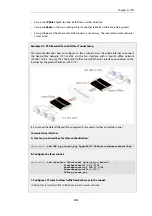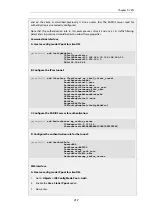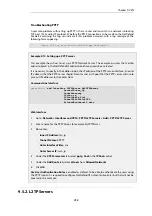
not be available to the IPsec client.
6.
The Windows VPN client can now be configured as normal except that IPv6 must be
disabled for the connection because this is not supported.
Configuration of NetDefendOS
For the NetDefendOS configuration, the setup steps are as follows:
1.
In NetDefendOS configure a
Config Mode Pool
object that will provide the IP addresses to
the connecting clients.
2.
Add the same CA root certificate to the NetDefendOS along with a host certificate signed by
the root certificate.
3.
Configure an
IPsec Tunnel
object that will be used for client connection.
4.
Configure a
RADIUS Server
object in NetDefendOS that will be used for EAP authentication. It
is recommended to use an EAP method of MSCHAPv2
5.
Configure an
Authentication Rule
object that will trigger on the connecting clients. The rule
should try to match the targeted traffic as closely as possible and should specify the Agent
property as
EAP
.
The details for the above NetDefendOS configuration steps can be found in the NetDefendOS
setup example found below.
RADIUS Server Setup
The following setup notes apply to a Microsoft
Network Policy Server
(NPS) and should be
adapted if another type of RADIUS server is being used. With an NPS, the following steps should
be performed:
1.
Under
NPS > Policies > Connection Request Policies
, add a
Connection Request Policy
.
2.
The
Type of network access server
should be set to
Unspecified
.
3.
The
Conditions
part of the policy specifies any restrictions.
4.
Under
NPS > Policies > Network Policies
, add a
Network Policy
with no restrictions.
5.
Under
Constraints
, select
Authentication
methods and then choose an EAP method. All EAP
options are supported but
EAP-MSCHAP v2
is recommended.
6.
Select the
NAS Port Type
section of
Constraints
and disable all options.
7.
Under
RADIUS Clients
, add the clients that will connect.
Example 9.9. IKEv2 EAP Client Setup
This example describes how to configure NetDefendOS to allow the setup of an IKEv2 IPsec
tunnel from a roaming client using EAP authentication. The default IKE and IPsec proposal lists
will be used.
The example assumed that the relevant certificates have been installed correctly in NetDefendOS
Chapter 9: VPN
716
Summary of Contents for NetDefendOS
Page 30: ...Figure 1 3 Packet Flow Schematic Part III Chapter 1 NetDefendOS Overview 30 ...
Page 32: ...Chapter 1 NetDefendOS Overview 32 ...
Page 144: ...Chapter 2 Management and Maintenance 144 ...
Page 284: ...Chapter 3 Fundamentals 284 ...
Page 392: ...Chapter 4 Routing 392 ...
Page 419: ... Host 2001 DB8 1 MAC 00 90 12 13 14 15 5 Click OK Chapter 5 DHCP Services 419 ...
Page 420: ...Chapter 5 DHCP Services 420 ...
Page 573: ...Chapter 6 Security Mechanisms 573 ...
Page 607: ...Chapter 7 Address Translation 607 ...
Page 666: ...Chapter 8 User Authentication 666 ...
Page 775: ...Chapter 9 VPN 775 ...
Page 819: ...Chapter 10 Traffic Management 819 ...
Page 842: ...Chapter 11 High Availability 842 ...
Page 866: ...Default Enabled Chapter 13 Advanced Settings 866 ...
Page 879: ...Chapter 13 Advanced Settings 879 ...









































